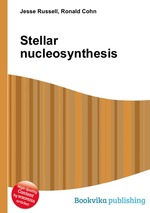Stellar nucleosynthesis
Jesse Russell Ronald Cohn
бумажная книга
High Quality Content by WIKIPEDIA articles! Stellar nucleosynthesis refers to the assembly of the natural abundances of the chemical elements by nuclear reactions occurring in the cores of stars. Those stars evolve (age) owing to the associated changes in the abundances of the elements within. Those stars lose most of their mass when it is ejected late in the stellar lifetimes, thereby enriching the interstellar gas in the abundances of elements heavier than helium. For the creation of elements during the explosion of a star, the term supernova nucleosynthesis is used. The goal is to understand the vastly differing abundances of the chemical elements and their several isotopes as a process of natural history. The primary stimulus to the development of this theory was the shape of the natural abundances. Those abundances, when plotted on a graph as a function of atomic number of the element, have a jagged sawtooth structure varying by factors of ten million. This suggested a natural process rather than a random distribution. Such a graph of the abundances can be seen at History of nucleosynthesis theory. Stellar nucleosynthesis is the most dominating contributor to several processes that also occur under the collective term nucleosynthesis.


